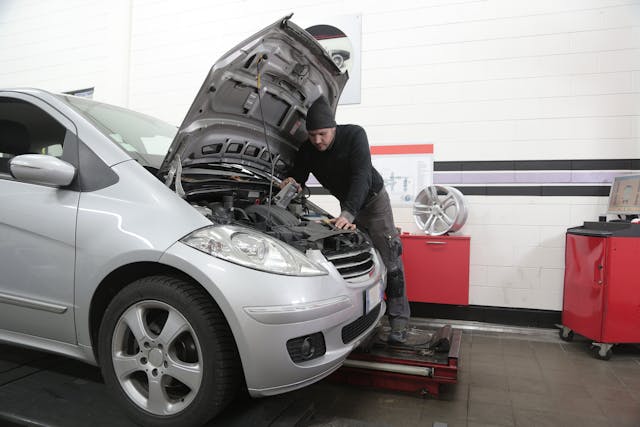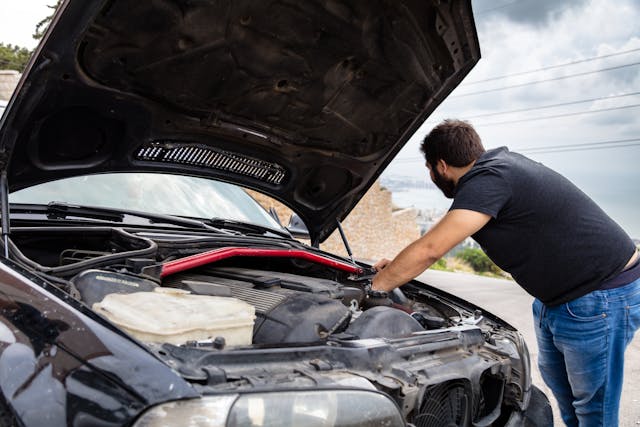A breakdown or technical trouble while on the road may be unpleasant and annoying for any motorist. Whether you’re driving to work or going on a road vacation, unexpected automobile difficulties may swiftly spoil your plans. However, with a little knowledge and ingenuity, many typical roadside issues may be resolved with quick solutions that will get you back on the road safely. In this post, we’ll look at emergency auto repairs and provide advice on how to deal with typical situations.
Flat tires are a common roadside concern for drivers. If you have a flat tire, the first step is to pull over in a safe spot away from traffic. Once securely parked, replace the flat tire with the spare tire kept in your car. Remember to exercise care while replacing the tire and make sure the spare tire is properly inflated. It’s also a good idea to check the damaged tire for apparent punctures and indications of wear.

A dead battery might leave you stuck, particularly if your car does not start. If you suspect a dead battery, try a jump start using jumper cables and another vehicle that has a functional battery. Connect the jumper wires to the battery terminals, ensuring appropriate polarity, and enable the charged battery to provide power to the dead battery. If a jump start does not work, you may need to contact roadside assistance or arrange for a tow to a repair facility.
Overheating engines demand prompt care. If you detect your engine temperature gauge increasing to the red zone or steam escaping from under the hood, pull over to a safe spot and switch off the engine right away. Allow the engine to cool before opening the hood and inspecting the cooling system. Check the coolant level and fill it up as needed, but do not remove the radiator cap while the engine is hot to risk injury.
A jammed brake caliper may lead to uneven braking and significant heat buildup, endangering vehicle safety. If you suspect a jammed brake caliper, try lightly hitting it with a hammer to free it. However, if the caliper remains stuck, avoid driving the car and seek expert help. Driving with a blocked brake caliper might cause further damage to the braking system and impair your ability to stop safely.
A damaged serpentine belt might disable your vehicle’s alternator, power steering pump, and air conditioning compressor. If you suffer a sudden loss of power steering or see the battery warning light lighted on your dashboard, it might be a damaged serpentine belt. Pull over promptly and switch off the engine to avoid more harm. Examine the serpentine belt for evidence of wear, damage, or fracture, and arrange for a tow to a repair shop if required.
Running out of petrol might leave you stuck on the road. If you run out of petrol, put on your warning lights and carefully pull over to the side of the road. If feasible, attempt to coast to a nearby gas station or request roadside assistance to deliver gasoline to your position. Consider storing an extra gasoline canister in your car for emergencies.
Electrical problems like blown fuses or faulty lights may jeopardize your vehicle’s safety and performance. If you have electrical troubles while driving, inspect the fuse box for any blown fuses and replace them as necessary. If an electrical component, such as a headlight or taillight, fails to operate correctly, consider employing temporary repairs like duct tape or homemade coverings to keep visibility until the problem is resolved permanently.
Transmission issues may include trouble changing gears, unusual sounds, or fluid leaks. If you suspect a transmission problem, pull over to a safe area and inspect the transmission fluid level and condition. Low or dirty transmission fluid may cause transmission difficulties and should be treated right away. If you can’t fix the problem on your own, get expert help from a knowledgeable technician.
Brake failure is a critical problem that needs prompt treatment. If your brakes fail while driving, be cool and concentrate on properly slowing down your vehicle. To stop the car, downshift to a lower gear or gently use the emergency/parking brake. When you’ve come to a halt, activate your hazard lights and dial 911 for help. Avoid driving until a professional inspects and repairs the vehicle’s braking system.
Untreated coolant leaks may cause engine overheating and damage. If you see coolant leaking from your car, pull over to a safe spot and switch off the engine right away. Allow the engine to cool before opening the hood and checking the cooling system for leaks. If the leak is slight, you may be able to temporarily seal it with radiator stop leak or duct tape until you can go to a repair shop.

In conclusion, although automotive faults are unavoidable, being prepared and knowledgeable about typical roadside issues may make a significant difference. By being cool, analyzing the situation, and taking proper action, you may confidently negotiate emergency auto repairs and return on the road safely. Remember to emphasize safety at all times and seek expert help when required. With the proper information and preparedness, you can tackle unforeseen automobile problems and continue your travel with peace of mind.
Frequently Asked Questions (FAQ) about Emergency Car Repairs:
1. What do I do if my automobile breaks down on the road?
If your automobile breaks down on the road, the first step is to carefully pull over to the side or shoulder. Turn on your warning lights to inform other cars, then analyze the situation carefully. Depending on the problem, you may need to try simple troubleshooting or contact for roadside help.
2. How should I plan for emergency auto repairs?
To be prepared for emergency auto repairs, carry a simple toolkit, flashlight, jumper cables, spare tire, and emergency supplies like water and non-perishable food in your vehicle. Familiarize yourself with the fundamental maintenance and emergency measures described in your vehicle’s owner handbook.
3. Can I try to repair my automobile myself in an emergency?
While some small concerns may be solved with simple equipment and expertise, it is critical to prioritize safety and understand your boundaries. Attempting difficult repairs or troubleshooting without the requisite knowledge may exacerbate the situation or cause more harm. If in doubt, seek expert help.
4. How do I know when I should contact for roadside assistance?
If you have a significant mechanical problem, a brake failure, or are trapped in a dangerous place, you should contact for roadside help. Towing, battery jump-starts, tire replacements, and other emergency services are all available from roadside help companies.
5. What do I do if my automobile runs out of gas?
If your vehicle runs out of gasoline, activate your warning lights and safely pull over to the side of the road. If feasible, coast to a nearby gas station or request roadside assistance to get gasoline to your position. Consider storing an extra gasoline canister in your car for emergencies.
6. How can I avoid emergency auto repairs?
Regular vehicle maintenance and inspections may help avoid many common automobile issues and lower the likelihood of an unexpected breakdown. To prevent possible problems, stick to the manufacturer’s maintenance plan, check fluid levels on a regular basis, and handle any warning indications or strange sounds as soon as they appear.
7. What should I do if my vehicle’s brakes fail while driving?
If your car’s brakes fail while driving, be cool and concentrate on properly slowing down your vehicle. To stop the car, downshift to a lower gear or gently use the emergency/parking brake. When you’ve come to a halt, activate your hazard lights and dial 911 for help. Avoid driving until a professional inspects and repairs the vehicle’s braking system.
8. Is it safe to try interim solutions to automotive problems?
Temporary repairs are useful for addressing minor concerns and getting you safely to a repair facility, but they should not be regarded permanent solutions. When trying interim repairs, use care and always place safety first. Seek expert aid for permanent repairs, and make sure that any temporary remedies are handled as soon as possible.